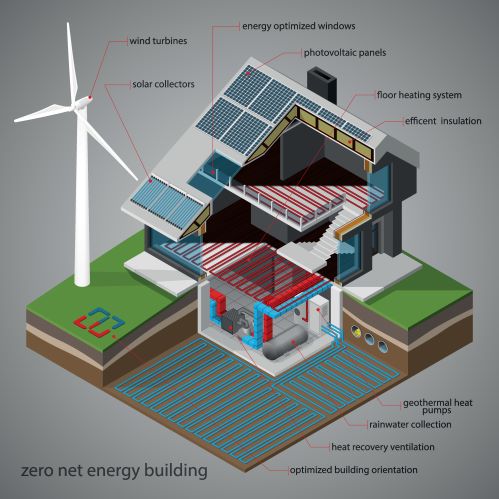Net Zero Buildings
Net Zero Buildings are designed to produce as much energy as they consume over the course of a year, significantly reducing greenhouse gas emissions associated with building operations.

Image credit: Source Name
job openings
View open jobs in this Solution
Example Organizations
- International Living Future Institute - Promotes sustainable building practices and certifications.
- U.S. Green Building Council - Develops LEED certification for green buildings.
- Architecture 2030 - Advocates for carbon-neutral buildings by 2030.
Overview
Net Zero Buildings aim to achieve a balance between energy consumed and energy produced on-site. This approach integrates energy-efficient design, renewable energy systems, and advanced building technologies to minimize environmental impact.
Learn More
Progress Made
Significant advancements have been made in net zero building technologies:
- High-Performance Building Envelopes: Improved insulation and air-sealing techniques reduce energy loss.
- Energy-Efficient Systems: Advanced HVAC, lighting, and appliances minimize energy consumption.
- On-Site Renewable Energy: Integration of solar panels, small wind turbines, and geothermal systems.
- Energy Management Systems: Smart technologies optimize building performance and energy use.
Solutions by Sector
Residential Buildings
- Passive House Design: Ultra-low energy building standard reducing heating and cooling needs.
- Net Zero Energy Homes: Residential buildings that produce as much energy as they consume annually.
- Deep Energy Retrofits: Comprehensive upgrades to existing homes to achieve near-net-zero performance.
Case Studies:
- zHome, Washington, USA: First net-zero energy townhome community in the United States (zHome).
- Solarsiedlung, Freiburg, Germany: Solar settlement with plus-energy houses (Solarsiedlung).
- Kaupuni Village, Hawaii, USA: Net-zero energy affordable housing development (Kaupuni Village).
Commercial Buildings
- Net Zero Energy Offices: Workplaces designed to balance energy consumption with on-site generation.
- Green Retail Spaces: Stores and shopping centers implementing net-zero strategies.
- Sustainable Schools: Educational facilities showcasing net-zero design and operations.
Case Studies:
- Unisphere, Maryland, USA: Largest commercial net-zero energy building in the USA (Unisphere).
- The Edge, Amsterdam, Netherlands: Smart office building with outstanding energy efficiency (The Edge).
- DPR Construction Phoenix Office, Arizona, USA: Net-positive energy office in a desert climate (DPR Construction).
Corporate Campuses
- Sustainable Corporate Headquarters: Companies integrating net-zero principles into their headquarters.
- Tech Campuses: Large tech companies leading by example in energy efficiency and sustainability.
- Innovation Hubs: Corporate campuses designed to foster innovation in sustainable practices.
Case Studies:
- Apple Park, California, USA: Apple's corporate campus claims to be powered entirely by renewable energy. However, critics argue that the company's supply chain still relies heavily on non-renewable energy sources, and the overall environmental impact of its products needs further scrutiny (Apple).
- Amazon Spheres, Seattle, USA: Incorporates energy-efficient systems and renewable energy sources. Yet, Amazon faces criticism for its carbon footprint from logistics and data centers (Amazon).
- Tesla Gigafactory, Nevada, USA: A net-zero energy factory producing batteries and electric vehicles. While Tesla's Gigafactory is a model of energy efficiency, the environmental impact of lithium mining for batteries remains a concern (Tesla).
Lessons Learned
- Holistic Approach: Successful net-zero buildings integrate multiple strategies and technologies.
- Occupant Behavior: User engagement is crucial for achieving and maintaining net-zero performance.
- Continuous Monitoring: Ongoing performance tracking and adjustments are essential.
- Climate-Specific Design: Net-zero strategies must be tailored to local climate conditions.
- Life-Cycle Considerations: Embodied carbon in materials and construction should be addressed.
Challenges Ahead
- High Initial Costs: Net-zero buildings often have higher upfront costs, despite long-term savings.
- Technical Complexity: Integrating various systems and technologies can be challenging.
- Retrofitting Existing Buildings: Upgrading older structures to net-zero standards is often difficult.
- Grid Integration: Balancing on-site generation with grid demands requires careful management.
- Policy and Regulation: Inconsistent building codes and policies can hinder widespread adoption.
Best Path Forward
- Policy Support: Implement supportive building codes and incentives for net-zero construction.
- Education and Training: Increase awareness and skills among architects, engineers, and builders.
- Research and Innovation: Continue developing cost-effective net-zero technologies and materials.
- Standardization: Establish clear, consistent standards for net-zero building performance.
- Financing Solutions: Develop innovative financing models to offset higher initial costs.
Image credit: Source Name